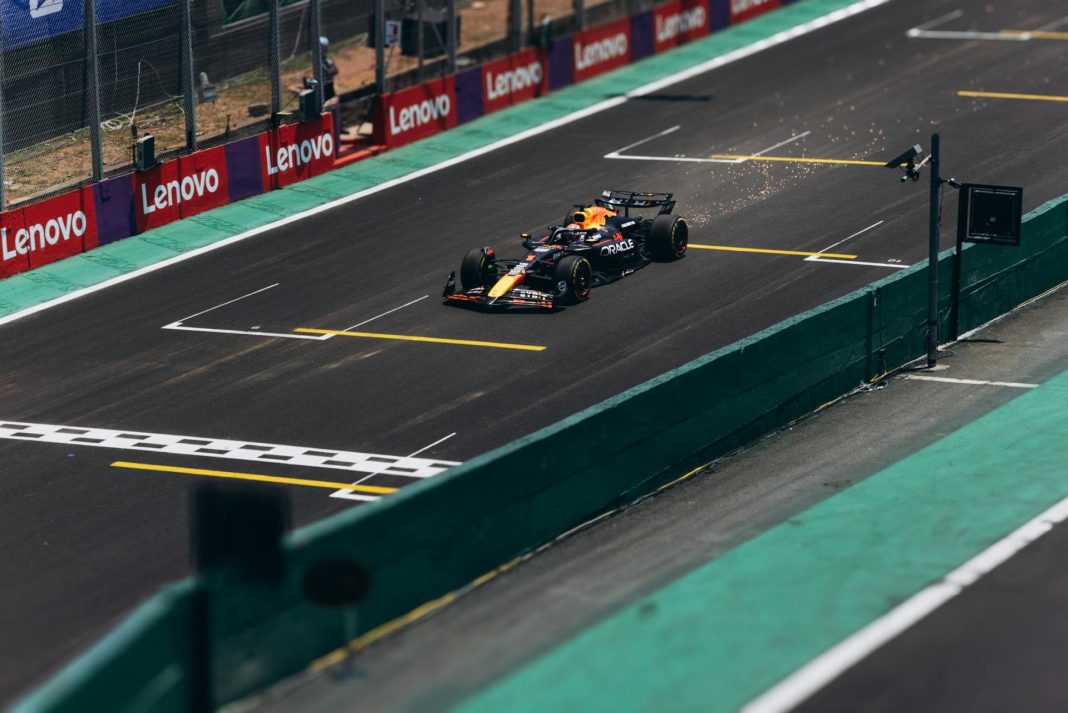On Tuesday the 18th of February, the world of Formula One took over the O2 Arena in a special livery reveal hosted by Jack Whitehall. What was framed as an event to celebrate 75 years of Formula 1 somehow slipped into a bizarre extravaganza of booing, DJs and Machine Gun Kelly.
On the surface, such excitement over a livery reveal may appear pointless: why such commotion over the colour of a car which is going to be exactly the same as last year? While it was officially in celebration of F1’s diamond jubilee, there seems to be something more commercial behind the proposal of this ‘anniversary’ event. F1 is in the honeymoon phase of unprecedented growth, where media conglomerates are opportune to capitalise on this popularity wave. ‘Bigger, better, brighter, bolder’ appears to be the agenda. Glitz and glamour, British icons, rehashing last year’s ‘beef’ between Russell and Verstappen. It’s simply giving the people what they want, isn’t it?
If adherence to fan’s wishes is the explanation for this increased showbiz we are seeing in motorsport, their interpretation of what fans want to see is somewhat inaccurate. Reception of the event has been controversial at best, with some fans appreciating the content at the end of a long winter break, while others describe reactions ranging from second-hand embarrassment to downright outrage.
Announcement of the event last November sparked apprehension among some drivers, particularly the outspoken kind, as four-time champion Max Verstappen joked on a live stream that he planned on being ill that week. Other drivers are also expressing humorous alarm, and even the fans felt snubbed when a large number of tickets for the event were reserved for influencers and media personalities.
When the day came, Verstappen’s dread seemed well-founded. All ten teams were offered seven minutes to display their liveries, mostly consumed by an entrance montage and brief driver interviews. The remaining time was filled with Whitehall’s comedic bits and music performances from Take That, Kane Brown, and MGK. One particularly memorable moment, if somewhat bamboozling to witness, included Bryan Tyler performing a lengthy solo DJ set to introduce the Alpine livery.
Despite dwindling hopes for the event, it was wonderful to see the 2025 grid and listen to interviews ahead of what is likely to be an eventful new season. The liveries themselves were eye-catching and beautifully crafted, and it was refreshing to see the rookies assimilating nicely into their new colours.
These positive features shouldn’t go unnoticed within the largely negative media whirlwind. However, what became apparent as the event progressed was that the F1 75 show was not necessarily a bad idea in principle, but it was almost undoubtedly a misfire in terms of its execution.
Verstappen in particular looked as if he would rather be anywhere else, and who can blame him? His suggestion that he may boycott the event if held in England next year, is unsurprising following the booing he received onstage. Granted, he was on British soil where allegiance to national drivers is fierce – it’s hard to imagine that the Dutchman would receive the same response in his home country. However, typical Verstappen sarcasm has made light of the whole fiasco, recently joking in a post-testing interview that ‘maybe I’m deaf…it was absolutely fantastic!’.
Another episode of crowd uproar was the FIA: the only acronym that produces more anger in a motorsport fan than DNF. The controversy around the FIA was bound to arise at this event, with recent introductions on swearing bans causing uproar among drivers and fans alike Indeed, One of the more redeemable moments of the evening involved Gordon Ramsay’s fine-worthy expletive when asked about the FIA’s new swearing policy.
Despite its disappointing execution, the growth F1-75 represents is not all bad. F1’s popularity has swelled recently, and the subsequent financial benefits can help fund grassroots programmes and increase employment across multiple sectors.
As sports go, it’s not inaccurate to argue that flashiness and prestige have long been part of motorsport’s identity. Often associated with wealth and Monte Carlo luxury, the recent media frenzy is perhaps just a more public extension of the glamour that F1 always held. But when events like F1-75 come with a tone of forcefulness and fabrication, it instead suggests the balance between sport and spectacle is starting to topple in an unsettling direction.
Verstappen could breathe a sigh of relief – currently, there are no plans for another livery reveal event next year. Still, as long as the fanbase continues its upward trajectory, it is entirely possible that similar episodes will take place in the sport’s future. If Britain does host another full-scale F1 spectacle, perhaps next time give Top Gear’s May, Clarkson or Hammond two hours and a microphone – if the FIA can handle a bit of profanity in the midst.
We are all waiting to hear Crofty telling us it’s ‘Lights out and away we go’ in Melbourne, but ‘lights, camera, action’ still doesn’t feel like an adequate replacement in the meantime. Formula One needs to find a way to balance the surge in media popularity while staying true to its identity as a sport, and the values and dignity of its participants.


